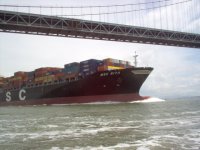On the last Delta/SF Bay Extravaganza, we encountered an unusually large wave in the bay on our way to the Oakland estruary towards Jack London Square. A large container ship (without tug escorts) was heading out from that area aiming between the Oakland Bay bridge supports increasing its throttle and rate of speed considerably -- I'd deem it reckless for that much speed in a close situation. A small sailboat was trying to cross its bow (too close) while it was accelerating. We four were well away from it's bow about 1/4-1/2 mile away also crossing it's path but not in danger (as long as our engines didn't fail that is...). The tanker was also executing a fairly sharp turn during this acceleration.
That was the situation, now the results. The tanker generated a rather large, steep wave off it's stern, I'd estimate it at 6-8 ft trough to peak and maybe 20-25 ft between the 2-3 peaks. Couldn't really see this wave from a distance because it was mostly a trough rather than a tall wave. This is what the 4 boats did, which was the best?
a) Salty-C's CD22 (1st) hit the throttle and turned parallel to the wave.
b) Pounder CD22 (2nd) turned perpendicular to the wave and slowed way down.
c) Dora~Jean CD25 (3rd) turned to hit wave at a 45 deg angle and slowed way down.
d) Discovery TC255 (4th) followed Dora~Jean's approach and speed.
My opinion later tonight after you have a chance to digest...
That was the situation, now the results. The tanker generated a rather large, steep wave off it's stern, I'd estimate it at 6-8 ft trough to peak and maybe 20-25 ft between the 2-3 peaks. Couldn't really see this wave from a distance because it was mostly a trough rather than a tall wave. This is what the 4 boats did, which was the best?
a) Salty-C's CD22 (1st) hit the throttle and turned parallel to the wave.
b) Pounder CD22 (2nd) turned perpendicular to the wave and slowed way down.
c) Dora~Jean CD25 (3rd) turned to hit wave at a 45 deg angle and slowed way down.
d) Discovery TC255 (4th) followed Dora~Jean's approach and speed.
My opinion later tonight after you have a chance to digest...

